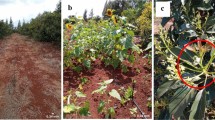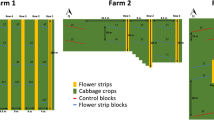Abstract
Collard greens Brassica oleracea (L.) are often attacked by various pests including whiteflies, aphids and diamondback moth. Hitherto, the main method used to manage these pests in Brazil has been the application of a limited number of registered insecticides. The search for more sustainable pest management strategies is therefore warranted. In this context, the conservation biological control stands out as an appealing alternative. Conservation biological control is achieved, at least in part, by strip-cultivating and/or conserving flowering plants within the agroecosystem. The present study investigates how alyssum flowers Lobularia maritima (L.) could contribute to the attraction of natural enemies and to the management of collard pests. Two field experiments were conducted in different years. Each experiment consisted of two treatments and three replicates, which were set up in a completely randomized design. The treatments were (1) collards alone, and (2) collards + alyssum. We evaluated weekly the population density of natural enemies and pests on both treatments. The results show that the alyssum flowers attractiveness contributed to increase the abundance of generalist predators during both experiments, which in turn translated into a significant reduction of collards pests, especially aphids. Some of the main predators attracted/harbored by alyssum flowers were spiders, coccinellids, syrphids and Orius sp. Finally, strip intercropping alyssum with collards can be an important strategy to manage brassica pests and cope with the limited availability of insecticides registered for this vegetable crop.





Similar content being viewed by others
References
Amaral DSSL, Venzon M, Duarte MVA, Sousa FF, Pallini A, Hardwood JD (2013) Non-crop vegetation associated with chili pepper agroecosystems promote the abundance and survival of aphid predators. Biol Control 64:338–346
Berndt LA, Wratten SD, Scarratt SL (2006) The influence of floral resource subsidies on parasitism rates of leafrollers (Lepidoptera: Tortricidae) in New Zealand vineyards. Biol Control 37:50–55
Bone NJ, Thomson LJ, Ridland PM, Cole P, Hoffmann AA (2009) Cover crops in Victorian apple orchards: effects on production, natural enemies and pests across a season. Crop Prot 28:675–683
Brennan EB (2013) Agronomic aspects of strip intercropping lettuce with alyssum for biological control of aphids. Biol Control 65:302–311
Brennan EB (2016) Agronomic aspects of strip intercropping broccoli with alyssum for biological control of aphids. Biol Control 97:109–119
Chaney WE (1998) Biological control of aphids in lettuce using in-field insectaries. In: Pickett CH, Bugg RL (eds) Enhancing biological control: habitat management to promote natural enemies of arthropod pests. University of California Press, Berkeley, pp 73–83
Colfer RJ, Rosenheim JA (2001) Predation on immature parasitoids and its impact on aphid suppression. Oecologia 126:292–304
Fiedler AK, Landis DA (2007) Plant characteristics associated with natural enemy abundance at Michigan native plants. Environ Entomol 36(4):878–886
Fiedler AK, Landis DA, Wratten SD (2008) Maximizing ecosystem services from conservation biological control: the role of habitat management. Biol Control 45:254–271
Firake DM, Lytan D, Behere GT (2012) Bio-diversity and seasonal activity of arthropod fauna in brassicaceous crop ecosystems of Meghalaya, north east India. Mol Entomol 3(4):18–22
Furlong MJ, Shi Z, Liu S, Zalucki MP (2004) Evaluation of the impact of natural enemies on Plutella xylostella L. (Lepidoptera: Yponomeutidae) populations on commercial brassica farms. Agric For Entomol 6(4):311–322
Gardiner MM, Landis DA, Gratton C, DiFonzo CD, O’Neal M, Chacon JM, Wayo MT, Schmidt NP, Mueller EE, Heimpel GE (2009) Landscape diversity enhances biological control of an introduced crop pest in the north-central USA. Ecol Appl 19:143–154
Gontijo LM (2011) Integrated biological control of woolly apple aphid in Washington State. PhD dissertation, Washington State University, Pullman, USA
Gontijo LM, Beers EH, Snyder WE (2013) Flowers promote aphid suppression in apple orchards. Biol Control 66:8–15
Grafton-Cardwell EE, Ouyang Y, Bugg RL (1999) Leguminous cover crops to enhance population development of Euseius tularensis (Acari: Phytoseiidae) in citrus. Biol Control 16:73–80
Gurr G, Wratten SD, Alteri MA (2004) Ecological engineering for pest management: advances in habitat manipulation for arthropods. CSIRO Publishing, Canberra
Harwood JD, Desneux N, Yoo HJS, Rowley DL, Greenstone MH, Obrycki JJ, O’Neil RJ (2007) Tracking the role of alternative prey in soybean aphid predation by Orius insidiosus: a molecular approach. Mol Ecol 16:4390–4400
Hassel MP, May RM (1986) Generalist and specialist natural enemies in insect predator-prey interactions. J Anim Ecol 55:923–940
Heimpel GE, Rosenheim JA, Mangel M (1997) Predation on adult Aphytis parasitoids in the field. Oecologia 110:346–352
Hickman JM, Wratten SD (1996) Use of Phacelia tanacetifolia strips to enhance biological control of aphids by hoverfly larvae in cereal fields. J Econ Entomol 89:832–840
Hogg BN, Nelson EH, Mills NJ, Daane KM (2011) Floral resources enhance aphid suppression by a hoverfly. Entomol Exp Appl 141:138–144
Horton DR, Broers DA, Hinojosa T, Lewis TM, Miliczky ER, Lewis RR (2002) Diversity and phenology of predatory arthropods overwintering in cardboard bands placed in pear and apple orchards of Central Washington State. Ann Entomol Soc Am 95:469–480
Kevan P, Giurfa M, Chittka L (1996) Why are there so many and so few white flowers? Trends Plant Sci 1:280–284
Landis DA, Wratten SD, Gurr GM (2000) Habitat management to conserve natural enemies of arthropod pests in agriculture. Annu Rev Entomol 45:175–201
Limburg DD, Rosenheim JA (2001) Extrafloral nectar consumption and its influence on survival and development of an omnivorous predator, larval Chrysoperla plorabunda (Neuroptera: Chrysopidae). Environ Entomol 30:595–604
Naranjo SE (2001) Conservation and evaluation of natural enemies in IPM systems for Bemisia tabaci. Crop Prot 20(9):835–852
Nieto DJ, Shennan C, Settle WH, O’malley R, Bros S, Honda JY (2006) How natural enemies and cabbage aphid (Brevicoryne brassicae L.) population dynamics affect organic broccoli harvest. Environ Entomol 94:94–101
Novo MCSS, Prela-Pantano A, Trani PE, Blat SF (2010) Desenvolvimento e produção de genótipos de couve manteiga. Hortic Bras 28:321–325
Oelofse M, Hogh-Jensenb H, Abreuc LS, Almeidad GF, Huie QY, Sultanf T, Neergaarda A (2010) Certified organic agriculture in China and Brazil: market accessibility and outcomes following adoption. Ecol Econ 69:1785–1793
Oliveira MRV, Amancio E, Laumann RA, Gomes LO (2003) Natural enemies of Bemisia tabaci (Gennadius) B biotype and Trialeurodes vaporariorum (Westwood) (Hemiptera: Aleyrodidae) in Brasília, Brazil. Neotrop Entomol 32:151–154
Patt JM, Hamilton GC, Lashomb JH (1997) Impact of strip-insectary intercropping with flowers on conservation biological control of the Colorado potato beetle. Adv Hortic Sci 11:175–181
Perdikis D, Fantinou A, Lykouressis D (2011) Enhancing pest control in annual crops by conservation of predatory Heteroptera. Biol Control 59:13–21
Ponti L, Altieri MA, Gutierrez AP (2007) Effects of crop diversification levels and fertilization regimes on abundance of Brevicoryne brassicae (L.) and its parasitization by Diaeretiella rapae (M’Intosh) in broccoli. Agric For Entomol 9:209–214
Ramsden MW, Menendez R, Leather SR, Wackers F (2015) Optimizing field margins for biocontrol services: the relative role of aphid abundance, annual floral resources, and overwinter habitat in enhancing aphid natural enemies. Agric Ecosyst Environ 199:94–104
Rand TA, Tylianakis JM, Tscharntke T (2006) Spillover edge effects: the dispersal of agriculturally subsidized insect natural enemies into adjacent natural habitats. Ecol Lett 9:603–614
Rosenheim JA, Wilhoit LR, Armer CA (1993) Influence of intraguild predation among generalist insect predators on the suppression of an herbivore population. Oecologia 96:439–449
Schmidt JM, Peterson JA, Lundgren JG, Hardwood JD (2013) Dietary supplementation with pollen enhances survival and Collembola boosts fitness of a web-building spider. Entomol Exp Appl 149:282–291
Symondson WOC, Sunderland KD, Greenstone MH (2002) Can generalist predators be effective biocontrol agents? Annu Rev Entomol 47:561–594
Tixier P, Dagneaux D, Mollot G, Vinatier F, Duyck PF (2013) Weeds mediate the level of intraguild predation in arthropod food webs. J Appl Entomol 137:702–710
Traugott M, Bell JR, Raso L, Sint D (2012) Generalist predators disrupt parasitoid aphid control by direct and coincidental intraguild predation. B Entomol Res 102:239–247
Tscharntke T, Klein AM, Kruess A, Steffan-Dewenter I, Thies C (2005) Landscape perspectives on agricultural intensification and biodiversity—ecosystem service management. Ecol Lett 8:857–874
Tukahirwa EM, Coaker TH (1982) Effect of mixed cropping on some insect pests of brassicas; reduced Brevicoryne brassicae infestations and influences on epigeal predators and the disturbance of oviposition behaviour in Delia brassicae. Entomol Exp Appl 32(2):129–140
Wade MR, Zalucki MP, Wratten SD, Robinson KA (2008) Conservation biological control of arthropods using artificial food sprays: current status and future challenges. Biol Control 45:185–199
White AJ, Wratten SD, Berry NA, Weigmann U (1995) Habitat manipulation to enhance biological control of brassica pests by hover flies (Diptera: Syrphidae). J Econ Entomol 88(5):1171–1176
Acknowledgements
We would like to thank Ênio Basilio, Lucas Ferreira Neto, Marta Ribeiro and Robson da Silva for helping with the experiment setup and some of the data collection.
Author information
Authors and Affiliations
Corresponding author
Additional information
Handling Editor: Marta Montserrat.
Electronic supplementary material
Below is the link to the electronic supplementary material.
Rights and permissions
About this article
Cite this article
Ribeiro, A.L., Gontijo, L.M. Alyssum flowers promote biological control of collard pests. BioControl 62, 185–196 (2017). https://doi.org/10.1007/s10526-016-9783-7
Received:
Accepted:
Published:
Issue Date:
DOI: https://doi.org/10.1007/s10526-016-9783-7




